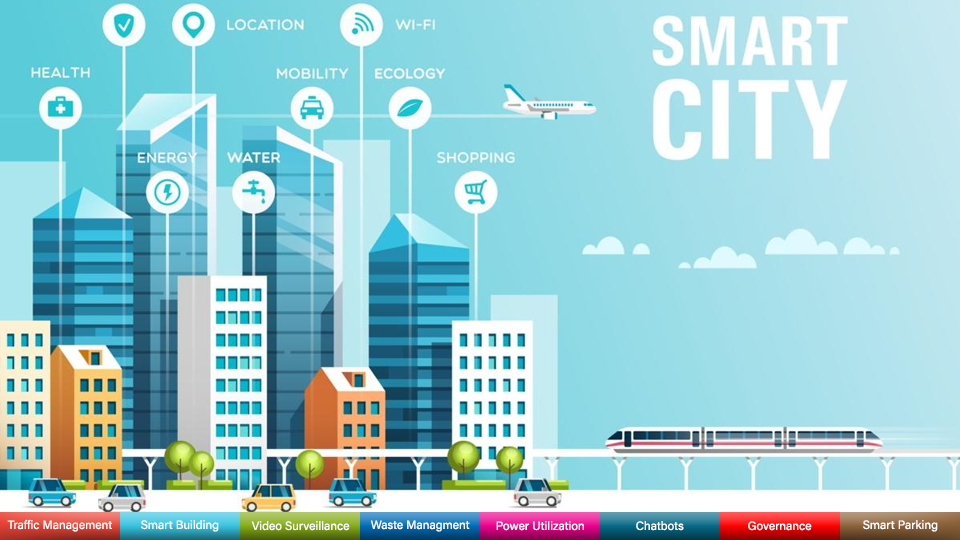![]()
Now a days common people and government officials are using “Smart City” as a buzzword. They are keen to create or convert the cities into “Smart” cities. It uses information and communication technologies (ICT) to boost the accomplishment and quality of metropolitan services like transportation, power and day to day life utilities. It will help to accelerate the economy by reducing the cost, reducing the wastage and optimizing use of resources. It is an urban area which uses various kinds of sensors to collect and utilize the data to optimize resource placements. The interpretation of “Smart City” varies geographically and demographically. The desire to adapt the structural reform, willingness to use new technology and fulfillment of the aspirations of people are key to the success of smart city implementation. An implication of a smart city implementation would be different for various countries.
Artificial intelligence (AI) plays a major role for turning a city in to smart city. AI is setting up the new technological trend in the society which might be never ending in the coming decades. AI has changed the quality of lifestyle completely as compared to a decade back. For example, a product is searched on an e-commerce website and it is not purchased, then the further web browsing shows the similar kind of product ads on other websites. Similarly, social networking websites like Facebook, Instagram, Twitter are impacting a social life through AI. Uber and Ola are kind of software which take care of your travel plan through AI and provide a hassle free travelling experience. Industries are now doing intense research for self driving cars as a part of smart city initiative. Smart cities are using AI based technology at very high pace than yesterday. AI helps in following ways to develop the smart city:
Traffic management
The number of vehicles hitting the roads increases as population grows. Thus, road traffic is a major concern for any government. A major objective of a smart city is to allow traveller to travel from one place to another safely and with shortest possible time. Better traffic flow management helps to reduce congestion, optimal use of resources and growth of economy. Adaptive signal control implemented in San Antonio, Los Angeles and Pittsburgh in U. S. A. is an example of use of AI for traffic flow management. It uses real time data to make traffic light timing adaptive and hence adjusting traffic flow.
Smart parking
Major metropolitan cities’ people struggle in getting parking space, especially during holidays. AI can help to improve the parking management by providing information about availability or unavailability of different parking spaces. It maximize the utilization of parking spaces and helps to reduce the traffic congestion. City of Adelaide, San Francisco and Redwood are cities which are equipped with such smart parking systems.
Smart building
Building contains various environmental sensors, safety equipment, lighting system, elevators. The controlling of such devices are done manually and building supervisors could not manage such systems efficiently all the time. AI powered controlling mechanism can help supervisors and optimize the utilization of resources.
Video surveillance for public safety
Biometric based security applications have gain much interest in past few years. These system fails to retrieve person from surveillance video due to low resolution, unconstrained environment and poor quality footage. For example, face recognition fails under such conditions. Conventionally, operators carry out person retrieval by manually searching through hours of videos. This is very inefficient. However, attributes like height, hair color, gender, ethnicity, cloth color, cloth type are useful for person retrieval under challenging condition. AI based system uses semantic description (e.g., Tall Male with Black T-shirt and Blue Jeans) of the person and help operators or security agencies to retrieve the person.
Waste management
It has become now little bit easy for city authorities to gather waste level data from the various part of the city through help of AI based technology. These data assist the officials to manage the waste in the city as well as it offers authorities with route and functional optimization.
Power utilization
Electricity is the key entity in 21st century. The optimal utilization of electricity can bring economic growth, save natural resources for future generations and provide the electricity to rural areas. Smart Grid is AI powered solution which stream line the use of power in the cities. The central management system of smart grid allows monitoring, control and analysis. It helps to improve efficiency, reduce energy consumption and optimize the resource utilization.
Chatbots
With huge amount of information and policy overflown everyday, every individual can not have the awareness about new policies. Chatbots helps to get information with very less response time. It is very useful for various government offices, banking and many more sectors. Specific and accurate information can be acquired by communicating with chatbots.
Governance
governments can implement the strategies with AI based application and do good governance. It helps to stream line the various process for its citizens. Also, the balancing solution need to develop which can handle various issues like Unemployment, Privacy, ethics, humanity and access to various tools.
Signing Off
In a nutshell, in today’s technology-driven era, the challenges of developing brown-field cities are different from green-field. But, the common to both of them is the understanding that technologies like AI and IoT will be the backbone, cornerstone, and smarter ways to transform cities into “intelligent” cities of tomorrow. As discussed above, to realize the smart city concept, cities should start welcoming Artificial Intelligent Solutions with open arms and take measures to incorporate them within the functions that make a municipality. Once that happens, no one can stop cities to become more efficient and livable.

